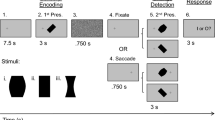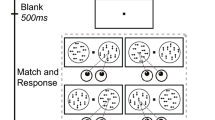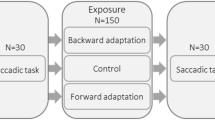Abstract
The influence of cognitive context on orienting behaviour can be explored using the mixed memory-prosaccade, memory-antisaccade task. A symbolic cue, such as the colour of a visual stimulus, instructs the subject to make a brief, rapid eye movement (a saccade) either towards the stimulus (prosaccade) or in the opposite direction (antisaccade)1,2,3. Thus, the appropriate sensorimotor transformation must be switched on to execute the instructed task. Despite advances in our understanding of the neuronal processing of antisaccades4,5,6,7,8, it remains unclear how the brain selects and computes the sensorimotor transformation leading to an antisaccade. Here we show that area LIP of the posterior parietal cortex is involved in these processes. LIP's population activity turns from the visual direction to the motor direction during memory-antisaccade trials. About one-third of the visual neurons in LIP produce a brisk, transient discharge in certain memory-antisaccade trials. We call this discharge ‘paradoxical’ because its timing is visual-like but its direction is motor. The paradoxical discharge shows, first, that switching occurs already at the level of visual cells, as previously proposed by Schlag-Rey and colleagues5; and second, that this switching is accomplished very rapidly, within 50 ms from the arrival of the visual signals in LIP.
This is a preview of subscription content, access via your institution
Access options
Subscribe to this journal
Receive 51 print issues and online access
$199.00 per year
only $3.90 per issue
Buy this article
- Purchase on Springer Link
- Instant access to full article PDF
Prices may be subject to local taxes which are calculated during checkout




Similar content being viewed by others
References
Hallett, P. E. Primary and secondary saccades to goals defined by instructions. Vision Res. 18, 1279–1296 (1978).
Amador, N., Schlag-Rey, M. & Schlag, J. Primate antisaccades. I. Behavioral characteristics. J. Neurophysiol. 80, 1775–1786 (1998).
Everling, S. & Fischer, B. The antisaccade: a review of basic research and clinical studies. Neuropsychologia 36, 885–899 (1998).
Funahashi, S., Chafee, M. V. & Goldman-Rakic, P. S. Prefrontal neuronal activity in rhesus monkeys performing a delayed anti-saccade task. Nature 365, 753–756 (1993).
Schlag-Rey, M., Amador, N., Sanchez, H. & Schlag, J. Antisaccade performance predicted by neuronal activity in the supplementary eye field. Nature 390, 398–401 (1997).
Gottlieb, J. & Goldberg, M. E. Activity of neurons in the lateral intraparietal area of the monkey during an antisaccade task. Nature Neurosci. 2, 906–912 (1999).
Everling, S., Dorris, M. C., Klein, R. M. & Munoz, D. P. Role of primate superior colliculus in preparation and execution of anti-saccades and pro-saccades. J. Neurosci. 19, 2740–2754 (1999).
Everling, S. & Munoz, D. P. Neuronal correlates for preparatory set associated with pro-saccades and anti-saccades in the primate frontal eye field. J. Neurosci. 20, 387–400 (2000).
Hikosaka, O. & Wurtz, R. H. Visual and oculomotor functions of monkey substantia nigra pars reticulata. III. Memory-contingent visual and saccade responses. J. Neurophysiol. 49, 1268–1284 (1983).
Gnadt, J. W. & Andersen, R. A. Memory related motor planning activity in posterior parietal cortex of macaque. Exp. Brain Res. 70, 216–220 (1988).
Barash, S., Bracewell, R. M., Fogassi, L., Gnadt, J. W. & Andersen, R. A. Saccade-related activity in the lateral intraparietal area. II. Spatial properties. J. Neurophysiol. 66, 1109–1124 (1991).
Barash, S., Bracewell, R. M., Fogassi, L., Gnadt, J. W. & Andersen, R. A. Saccade-related activity in the lateral intraparietal area. I. Temporal properties; comparison with area 7a. J. Neurophysiol. 66, 1095–1108 (1991).
Colby, C. L., Duhamel, J. R. & Goldberg, M. E. Visual, presaccadic, and cognitive activation of single neurons in monkey lateral intraparietal area. J. Neurophysiol. 76, 2841–2852 (1996).
Snyder, L. H., Batista, A. P. & Andersen, R. A. Coding of intention in the posterior parietal cortex. Nature 386, 167–170 (1997).
Chafee, M. V. & Goldman-Rakic, P. S. Matching patterns of activity in primate prefrontal area 8a and parietal area 7ip neurons during a spatial working memory task. J. Neurophysiol. 79, 2919–2940 (1998).
Duhamel, J. R., Colby, C. L. & Goldberg, M. E. The updating of the representation of visual space in parietal cortex by intended eye movements. Science 255, 90–92 (1992).
Andersen, R. A. in Handbook of Physiology, Section 1: The Nervous System (eds Mountcastle, V. B., Plum, F. & Geiger, S. R.) 483–518 (Am. Physiol. Soc., Bethesda, 1987).
Everling, S., Spantekow, A., Krappmann, P. & Flohr, H. Event-related potentials associated with correct and incorrect responses in a cued antisaccade task. Exp. Brain Res. 118, 27–34 (1998).
Horwitz, G. D. & Newsome, W. T. Separate signals for target selection and movement specification in the superior colliculus. Science 284, 1158–1161 (1999).
Grunewald, A., Linden, J. F. & Andersen, R. A. Responses to auditory stimuli in macaque lateral intraparietal area. I. Effects of training. J. Neurophysiol. 82, 330–342 (1999).
Thier, P. & Andersen, R. A. Electrical microstimulation distinguishes distinct saccade-related areas in the posterior parietal cortex. J. Neurophysiol. 80, 1713–1735 (1998).
Colby, C. L., Gattass, R., Olson, C. R. & Gross, C. G. Topographical organization of cortical afferents to extrastriate visual area PO in the macaque: a dual tracer study. J. Comp. Neurol. 269, 392–413 (1988).
Barash, S., Melikyan, A., Sivakov, A. & Tauber, M. Shift of visual fixation dependent on background illumination. J. Neurophysiol. 79, 2766–2781 (1998).
Newsome, W. T., Britten, K. H. & Movshon, J. A. Neuronal correlates of a perceptual decision. Nature 341, 52–54 (1989).
Acknowledgements
We thank E. Ahissar for his involvement, and A. Melikyan and X. Wang for participation in some experiments. We thank M. Glickstein, P. Thier, E. Seidemann, Y. Ritov and M. Tsodyks for discussions and for reading the manuscript. This work was supported by the Israel Science Foundation, and by the Murray H. and Meyer Grodetsky Center for Research of Higher Brain Functions and the Einhorn-Dominic Institute of Brain Research at the Weizmann Institute, and by the Paul Godfrey Research Foundation.
Author information
Authors and Affiliations
Corresponding author
Rights and permissions
About this article
Cite this article
Zhang, M., Barash, S. Neuronal switching of sensorimotor transformations for antisaccades. Nature 408, 971–975 (2000). https://doi.org/10.1038/35050097
Received:
Accepted:
Issue Date:
DOI: https://doi.org/10.1038/35050097
This article is cited by
-
Conflict detection and resolution in macaque frontal eye fields
Communications Biology (2024)
-
Dynamic spatial coding in parietal cortex mediates tactile-motor transformation
Nature Communications (2023)
-
Marmosets: a promising model for probing the neural mechanisms underlying complex visual networks such as the frontal–parietal network
Brain Structure and Function (2021)
-
Pro- and antisaccade task-switching: response suppression—and not vector inversion—contributes to a task-set inertia
Experimental Brain Research (2019)
-
Manipulating stored phonological input during verbal working memory
Nature Neuroscience (2017)
Comments
By submitting a comment you agree to abide by our Terms and Community Guidelines. If you find something abusive or that does not comply with our terms or guidelines please flag it as inappropriate.



